Holocene
The Holocene ( /ˈhɒl.əˌsiːn, ˈhɒl.oʊ-, ˈhoʊ.lə-, ˈhoʊ.loʊ-/ HOL-ə-seen, HOL-oh-, HOH-lə-, HOH-loh-)[3][4] is the current geological epoch. It began approximately 11,650 cal years before present, after the last glacial period, which concluded with the Holocene glacial retreat.[5] The Holocene and the preceding Pleistocene[6] together form the Quaternary period. The Holocene has been identified with the current warm period, known as MIS 1. It is considered by some to be an interglacial period within the Pleistocene Epoch, called the Flandrian interglacial.[7]
| Subdivisions of the Quaternary System | ||||
|---|---|---|---|---|
| System/ Period |
Series/ Epoch |
Stage/ Age |
Age (Ma) | |
| Quaternary | Holocene | Meghalayan | 0 | 0.0042 |
| Northgrippian | 0.0042 | 0.0082 | ||
| Greenlandian | 0.0082 | 0.0117 | ||
| Pleistocene | 'Upper' | 0.0117 | 0.129 | |
| Chibanian or 'Middle' | 0.129 | 0.774 | ||
| Calabrian | 0.774 | 1.80 | ||
| Gelasian | 1.80 | 2.58 | ||
| Neogene | Pliocene | Piacenzian | 2.58 | 3.60 |
Subdivision of the Quaternary Period according to the ICS, as of May 2019.[1]
For the Holocene, dates are relative to the year 2000 (e.g. Greenlandian began 11,700 years before 2000). For the beginning of the Northgrippian a date of 8,236 years before 2000 has been set.[2] The Meghalayan has been set to begin 4,250 years before 2000.[1] 'Tarantian' is an informal, unofficial name proposed for a stage/age to replace the equally informal, unofficial 'Upper Pleistocene' subseries/subepoch. In Europe and North America, the Holocene is subdivided into Preboreal, Boreal, Atlantic, Subboreal, and Subatlantic stages of the Blytt–Sernander time scale. There are many regional subdivisions for the Upper or Late Pleistocene; usually these represent locally recognized cold (glacial) and warm (interglacial) periods. The last glacial period ends with the cold Younger Dryas substage. | ||||
| Part of a series on | |||
| Human history Human Era | |||
|---|---|---|---|
| ↑ Prehistory (Pleistocene epoch) | |||
| Holocene | |||
|
|
|||
| Ancient | |||
|
|
|||
| Postclassical | |||
|
|
|||
| Modern | |||
|
|||
| ↓ Future | |||
| Preceded by the Pleistocene |
| Holocene Epoch |
|---|
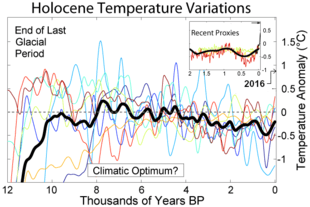 Holocene temperature variations |
|
|
Blytt–Sernander stages/ages
*Relative to year 2000 (b2k). †Relative to year 1950 (BP/Before "Present"). |
The Holocene corresponds with rapid proliferation, growth and impacts of the human species worldwide, including all of its written history, technological revolutions, development of major civilizations, and overall significant transition towards urban living in the present. The human impact on modern-era Earth and its ecosystems may be considered of global significance for the future evolution of living species, including approximately synchronous lithospheric evidence, or more recently hydrospheric and atmospheric evidence of the human impact. In July 2018, the International Union of Geological Sciences split the Holocene epoch into three distinct subsections, Greenlandian (11,700 years ago to 8,200 years ago), Northgrippian (8,200 years ago to 4,200 years ago) and Meghalayan (4,200 years ago to the present), as proposed by International Commission on Stratigraphy.[8] The boundary stratotype of the Meghalayan is a speleothem in Mawmluh cave in India,[9] and the global auxiliary stratotype is an ice core from Mount Logan in Canada.[10]
Etymology
The word is formed from two Ancient Greek words. Holos (ὅλος) is the Greek word for "whole." "Cene" comes from the Greek word kainos (καινός), meaning "new." The concept is that this epoch is "entirely new."[11][12][13] The suffix '-cene' is used for all the seven epochs of the Cenozoic Era.
Overview
It is accepted by the International Commission on Stratigraphy that the Holocene started approximately 11,650 cal years BP.[5] The Subcommission on Quaternary Stratigraphy quotes Gibbard and van Kolfschoten in Gradstein Ogg and Smith in stating the term 'Recent' as an alternative to Holocene is invalid and should not be used; it also observes that the term Flandrian, derived from marine transgression sediments on the Flanders coast of Belgium, has been used as a synonym for Holocene by authors who consider the last 10,000 years should have the same stage-status as previous interglacial events and thus be included in the Pleistocene.[14] The International Commission on Stratigraphy, however, considers the Holocene an epoch following the Pleistocene and specifically the last glacial period. Local names for the last glacial period include the Wisconsinan in North America,[15] the Weichselian in Europe,[16] the Devensian in Britain,[17] the Llanquihue in Chile[18] and the Otiran in New Zealand.[19]
The Holocene can be subdivided into five time intervals, or chronozones, based on climatic fluctuations:[20]
- Preboreal (10 ka–9 ka BP),
- Boreal (9 ka–8 ka BP),
- Atlantic (8 ka–5 ka BP),
- Subboreal (5 ka–2.5 ka BP) and
- Subatlantic (2.5 ka BP–present).
- Note: "ka" means "kilo-annum" Before Present, i.e. 1,000 years before 1950 (non-calibrated C14 dates)

The Blytt–Sernander classification of climatic periods initially defined by plant remains in peat mosses, is currently being explored. Geologists working in different regions are studying sea levels, peat bogs and ice core samples by a variety of methods, with a view toward further verifying and refining the Blytt–Sernander sequence. They find a general correspondence across Eurasia and North America, though the method was once thought to be of no interest. The scheme was defined for Northern Europe, but the climate changes were claimed to occur more widely. The periods of the scheme include a few of the final pre-Holocene oscillations of the last glacial period and then classify climates of more recent prehistory.
Paleontologists have not defined any faunal stages for the Holocene. If subdivision is necessary, periods of human technological development, such as the Mesolithic, Neolithic, and Bronze Age, are usually used. However, the time periods referenced by these terms vary with the emergence of those technologies in different parts of the world.
Climatically, the Holocene may be divided evenly into the Hypsithermal, with warmer temperatures on average in many regions, and Neoglacial periods. The boundary coincides with the start of the Bronze Age in Europe.
According to some scholars, a third division, the Anthropocene, has now begun.[22] This term is used to denote the present time interval in which many geologically significant conditions and processes have been profoundly altered by human activities. The ‘Anthropocene’ (a term coined by Paul Crutzen and Eugene Stoermer in 2000) is not a formally defined geological unit. The Subcommission on Quaternary Stratigraphy of the International Commission on Stratigraphy has a working group to determine whether it should be. In May 2019, members of the working group voted in favour of recognizing the Anthropocene as formal chrono-stratigraphic unit, with stratigraphic signals around the mid-twentieth century C.E. as its base. The exact criteria have still to be decided upon, after which the recommendation also has to be approved by the working group’s parent bodies (ultimately the International Union of Geological Sciences).[23]
Geology
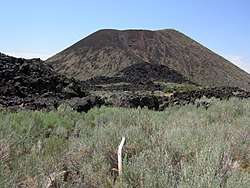
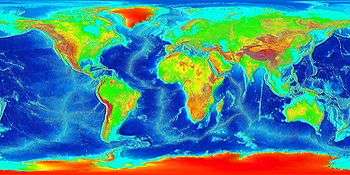
Continental motions due to plate tectonics are less than a kilometre over a span of only 10,000 years. However, ice melt caused world sea levels to rise about 35 m (115 ft) in the early part of the Holocene. In addition, many areas above about 40 degrees north latitude had been depressed by the weight of the Pleistocene glaciers and rose as much as 180 m (590 ft) due to post-glacial rebound over the late Pleistocene and Holocene, and are still rising today.[24]
The sea level rise and temporary land depression allowed temporary marine incursions into areas that are now far from the sea. Holocene marine fossils are known, for example, from Vermont and Michigan. Other than higher-latitude temporary marine incursions associated with glacial depression, Holocene fossils are found primarily in lakebed, floodplain, and cave deposits. Holocene marine deposits along low-latitude coastlines are rare because the rise in sea levels during the period exceeds any likely tectonic uplift of non-glacial origin.
Post-glacial rebound in the Scandinavia region resulted in the formation of the Baltic Sea. Earthquakes are a leading cause of sediment deformation, leading to the creation and destruction of bodies of water.[25] The region continues to rise, still causing weak earthquakes across Northern Europe. The equivalent event in North America was the rebound of Hudson Bay, as it shrank from its larger, immediate post-glacial Tyrrell Sea phase, to near its present boundaries.[26]
Climate
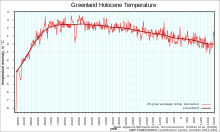
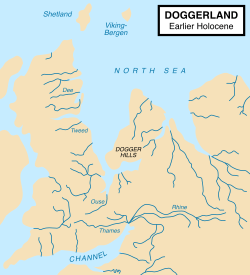
Climate has been fairly stable over the Holocene. Ice core records show that before the Holocene there was global warming after the end of the last ice age and cooling periods, but climate changes became more regional at the start of the Younger Dryas. During the transition from the last glacial to the Holocene, the Huelmo–Mascardi Cold Reversal in the Southern Hemisphere began before the Younger Dryas, and the maximum warmth flowed south to north from 11,000 to 7,000 years ago. It appears that this was influenced by the residual glacial ice remaining in the Northern Hemisphere until the later date.
The Holocene climatic optimum (HCO) was a period of warming in which the global climate became warmer. However, the warming was probably not uniform across the world. This period of warmth ended about 5,500 years ago with the descent into the Neoglacial and concomitant Neopluvial. At that time, the climate was not unlike today's, but there was a slightly warmer period from the 10th–14th centuries known as the Medieval Warm Period. This was followed by the Little Ice Age, from the 13th or 14th century to the mid-19th century.
Compared to glacial conditions, habitable zones have expanded northwards, reaching their northernmost point during the HCO. Greater moisture in the polar regions has caused the disappearance of steppe-tundra.
The temporal and spatial extent of Holocene climate change is an area of considerable uncertainty, with radiative forcing recently proposed to be the origin of cycles identified in the North Atlantic region. Climate cyclicity through the Holocene (Bond events) has been observed in or near marine settings and is strongly controlled by glacial input to the North Atlantic.[27][28] Periodicities of ≈2500, ≈1500, and ≈1000 years are generally observed in the North Atlantic.[29][30][31] At the same time spectral analyses of the continental record, which is remote from oceanic influence, reveal persistent periodicities of 1,000 and 500 years that may correspond to solar activity variations during the Holocene epoch.[32] A 1,500-year cycle corresponding to the North Atlantic oceanic circulation may have had widespread global distribution in the Late Holocene.[32]
Ecological developments
Animal and plant life have not evolved much during the relatively short Holocene, but there have been major shifts in the distributions of plants and animals. A number of large animals including mammoths and mastodons, saber-toothed cats like Smilodon and Homotherium, and giant sloths disappeared in the late Pleistocene and early Holocene—especially in North America, where animals that survived elsewhere (including horses and camels) became extinct. This extinction of American megafauna has been explained as caused by the arrival of the ancestors of Amerindians; though most scientists assert that climatic change also contributed. In addition, a controversial bolide impact over North America has been hypothesized to have triggered the Younger Dryas.[33]
Throughout the world, ecosystems in cooler climates that were previously regional have been isolated in higher altitude ecological "islands".[34]
The 8.2 ka event, an abrupt cold spell recorded as a negative excursion in the δ18O record lasting 400 years, is the most prominent climatic event occurring in the Holocene epoch, and may have marked a resurgence of ice cover. It has been suggested that this event was caused by the final drainage of Lake Agassiz, which had been confined by the glaciers, disrupting the thermohaline circulation of the Atlantic.[35] Subsequent research, however, suggested that the discharge was probably superimposed upon a longer episode of cooler climate lasting up to 600 years and observed that the extent of the area affected was unclear.[36]
Human developments

The beginning of the Holocene corresponds with the beginning of the Mesolithic age in most of Europe, but in regions such as the Middle East and Anatolia with a very early neolithisation, Epipaleolithic is preferred in place of Mesolithic. Cultures in this period include Hamburgian, Federmesser, and the Natufian culture, during which the oldest inhabited places still existing on Earth were first settled, such as Tell es-Sultan (Jericho) in the Middle East.[37] There is also evolving archeological evidence of proto-religion at locations such as Göbekli Tepe, as long ago as the 9th millennium BCE.[38]
Both are followed by the aceramic Neolithic (Pre-Pottery Neolithic A and Pre-Pottery Neolithic B) and the pottery Neolithic. The Late Holocene brought advancements such as the bow and arrow and saw new methods of warfare in North America. Spear throwers and their large points were replaced by the bow and arrow with its small narrow points beginning in Oregon and Washington. Villages built on defensive bluffs indicate increased warfare, leading to food gathering in communal groups for protection rather than individual hunting.[39] In Mesoamerica, transformations of natural environments have been a common feature at least since the mid-Holocene, mostly through the exploitation of wild plants and the establishment of crops.[40]
See also
- 8.2 kiloyear event
- 10th millennium BCE
- Blytt–Sernander system
- Holocene calendar
- Holocene extinction
- Neolithic Subpluvial
- Older Peron
- Outburst flood
- Piora Oscillation
- Quaternary extinction event
References
- Cohen, K. M.; Finney, S. C.; Gibbard, P. L.; Fan, J.-X. (January 2020). "International Chronostratigraphic Chart" (PDF). International Commission on Stratigraphy. Retrieved 23 February 2020.
- Mike Walker; et al. (December 2018). "Formal ratification of the subdivision of the Holocene Series/Epoch (Quaternary System/Period)" (PDF). Episodes. Subcommission on Quaternary Stratigraphy (SQS). 41 (4): 213–223. doi:10.18814/epiiugs/2018/018016. Retrieved 11 November 2019. This proposal on behalf of the SQS has been approved by the International Commission on Stratigraphy (ICS) and formally ratified by the Executive Committee of the International Union of Geological Sciences (IUGS).
- "Holocene". Merriam-Webster Dictionary. Retrieved February 11, 2018.
- "Holocene". Dictionary.com Unabridged. Random House. Retrieved February 11, 2018.
- Walker, Mike; Johnsen, Sigfus; Rasmussen, Sune Olander; Popp, Trevor; Steffensen, Jorgen-Peder; Gibrard, Phil; Hoek, Wim; Lowe, John; Andrews, John; Bjo Rck, Svante; Cwynar, Les C.; Hughen, Konrad; Kersahw, Peter; Kromer, Bernd; Litt, Thomas; Lowe, David J.; Nakagawa, Takeshi; Newnham, Rewi; Schwander, Jakob (2009). "Formal definition and dating of the GSSP (Global Stratotype Section and Point) for the base of the Holocene using the Greenland NGRIP ice core, and selected auxiliary records" (PDF). Journal of Quaternary Science. 24 (1): 3–17. Bibcode:2009JQS....24....3W. doi:10.1002/jqs.1227.
- Fan, Junxuan; Hou, Xudong. "International Chronostratigraphic Chart". International Commission on Stratigraphy. Retrieved June 18, 2016.
- Oxford University Press – Why Geography Matters: More Than Ever (book) – "Holocene Humanity" section https://books.google.com/books?id=7P0_sWIcBNsC
- Amos, Jonathan (2018-07-18). "Welcome to the Meghalayan Age a new phase in history". BBC News.
- "Collapse of civilizations worldwide defines youngest unit of the Geologic Time Scale".
- Formal subdivision of the Holocene Series/Epoch
- The name "Holocene" was proposed in 1850 by the French palaeontologist and entomologist Paul Gervais (1816–1879): Gervais, Paul (1850). "Sur la répartition des mammifères fossiles entre les différents étages tertiaires qui concourent à former le sol de la France" [On the distribution of mammalian fossils among the different tertiary stages which help to form the ground of France]. Académie des Sciences et Lettres de Montpellier. Section des Sciences (in French). 1: 399–413. From p. 413: "On pourrait aussi appeler Holocènes, ceux de l'époque historique, ou dont le dépôt n'est pas antérieur à la présence de l'homme ; … " (One could also call "Holocene" those [deposits] of the historic era, or the deposit of which is not prior to the presence of man ; … )
- "Origin and meaning of Holocene". Online Etymology Dictionary. Retrieved 2019-08-08.
- "Origin and meaning of suffix -cene". Online Etymology Dictionary. Retrieved 2019-08-08.
- Gibbard, P.L. (January 4, 2016). "History of the stratigraphical nomenclature of the glacial period". Subcommission on Quaternary Stratigraphy. International Commission on Stratigraphy. Retrieved June 18, 2017.
- Clayton, Lee; Moran, Stephen R. (1982). "Chronology of late wisconsinan glaciation in middle North America". Quaternary Science Reviews. 1 (1): 55–82. Bibcode:1982QSRv....1...55C. doi:10.1016/0277-3791(82)90019-1.
- Svendsen, John Inge; Astakhov, Valery I.; Bolshiyanov, Dimitri Yu.; Demidov, Igor; Dowdeswell, Julian A.; Gataullin, Valery; Hjort, Christian; Hubberten, Hans W.; Larsen, Eiliv; Mangerud, Jan; Melles, Martin; Moller, Per; Saarnisto, Matti; Siegert, Martin J. (March 1999). "Maximum extent of the Eurasian ice sheets in the Barents and Kara Sea region during the Weichselian" (PDF). Boreas. 28 (1): 234–242. doi:10.1111/j.1502-3885.1999.tb00217.x.
- Eyles, Nicholas; McCabe, A. Marshall (1989). "The Late Devensian (<22,000 BP) Irish Sea Basin: The sedimentary record of a collapsed ice sheet margin". Quaternary Science Reviews. 8 (4): 307–351. Bibcode:1989QSRv....8..307E. doi:10.1016/0277-3791(89)90034-6.
- Denton, G.H.; Lowell, T.V.; Heusser, C.J.; Schluchter, C.; Andersern, B.G.; Heusser, Linda E.; Moreno, P.I.; Marchant, D.R. (1999). "Geomorphology, stratigraphy, and radiocarbon chronology of LlanquihueDrift in the area of the Southern Lake District, Seno Reloncavi, and Isla Grande de Chiloe, Chile" (PDF). Geografiska Annaler Series a Physical Geography. 81A (2): 167–229. doi:10.1111/j.0435-3676.1999.00057.x.
- Newnham, R.M.; Vandergoes, M.J.; Hendy, C.H.; Lowe, D.J.; Preusser, F. (February 2007). "A terrestrial palynological record for the last two glacial cycles from southwestern New Zealand". Quaternary Science Reviews. 26 (3–4): 517–535. Bibcode:2007QSRv...26..517N. doi:10.1016/j.quascirev.2006.05.005.
- Mangerud, Jan; Anderson, Svend T.; Berglund, Bjorn E.; Donner, Joakim J. (October 1, 1974). "Quaternary stratigraphy of Norden: a proposal for terminology and classification" (PDF). Boreas. 3 (3): 109–128. doi:10.1111/j.1502-3885.1974.tb00669.x.
- Zalloua, Pierre A.; Matisoo-Smith, Elizabeth (6 January 2017). "Mapping Post-Glacial expansions: The Peopling of Southwest Asia". Scientific Reports. 7: 40338. Bibcode:2017NatSR...740338P. doi:10.1038/srep40338. ISSN 2045-2322. PMC 5216412. PMID 28059138.
- Pearce, Fred (March 15, 2007). With Speed and Violence. Beacon Press. p. 21. ISBN 978-0-8070-8576-9.
- "Working Group on the "Anthropocene"". Subcommission on Quaternary Stratigraphy. International Commission on Stratigraphy. January 4, 2016. Retrieved June 18, 2017.
- Gray, Louise (October 7, 2009). "England is sinking while Scotland rises above sea levels, according to new study". The Daily Telegraph. Retrieved June 10, 2014.
- Holocene : perspectives, environmental dynamics, and impact events. Kotlia, Bahadur Singh. Hauppauge, N.Y.: Nova Science Publishers. 2013. ISBN 978-1622577255. OCLC 846551611.CS1 maint: others (link)
- Lajeuness, Patrick; Allard, Michael (2003). "The Nastapoka drift belt, eastern Hudson Bay: implications of a stillstand of the Quebec-Labrador ice margin in the Tyrrell Sea at 8 ka BP" (PDF). Canadian Journal of Earth Sciences. 40: 65–76. doi:10.1139/e02-085. Archived from the original (PDF) on 2004-03-22.
- Bond, G.; et al. (1997). "A Pervasive Millennial-Scale Cycle in North Atlantic Holocene and Glacial Climates" (PDF). Science. 278 (5341): 1257–1266. Bibcode:1997Sci...278.1257B. doi:10.1126/science.278.5341.1257. Archived from the original (PDF) on 2008-02-27.
- Bond, G.; et al. (2001). "Persistent Solar Influence on North Atlantic Climate During the Holocene". Science. 294 (5549): 2130–2136. Bibcode:2001Sci...294.2130B. doi:10.1126/science.1065680. PMID 11739949.
- Bianchi, G.G.; McCave, I.N. (1999). "Holocene periodicity in North Atlantic climate and deep-ocean flow south of Iceland". Nature. 397 (6719): 515–517. Bibcode:1999Natur.397..515B. doi:10.1038/17362.
- Viau, A.E.; Gajewski, K.; Sawada, M.C.; Fines, P. (2006). "Millennial-scale temperature variations in North America during the Holocene". Journal of Geophysical Research. 111 (D9): D09102. Bibcode:2006JGRD..111.9102V. doi:10.1029/2005JD006031.
- Debret, M.; Sebag, D.; Crosta, X.; Massei, N.; Petit, J.-R.; Chapron, E.; Bout-Roumazeilles, V. (2009). "Evidence from wavelet analysis for a mid-Holocene transition in global climate forcing" (PDF). Quaternary Science Reviews. 28 (25): 2675–2688. Bibcode:2009QSRv...28.2675D. doi:10.1016/j.quascirev.2009.06.005.
- Kravchinsky, V.A.; Langereis, C.G.; Walker, S.D.; Dlusskiy, K.G.; White, D. (2013). "Discovery of Holocene millennial climate cycles in the Asian continental interior: Has the sun been governing the continental climate?". Global and Planetary Change. 110: 386–396. Bibcode:2013GPC...110..386K. doi:10.1016/j.gloplacha.2013.02.011.
- Dalton, Rex (May 17, 2007). "Blast from the Past? A controversial new idea suggests that a big space rock exploded on or above North America at the end of the last ice age" (PDF). Nature. 447 (7142): 256–257. Bibcode:2007Natur.447..256D. doi:10.1038/447256a. PMID 17507957. Archived from the original (PDF) on December 1, 2017.
- Singh, Ashbindu (2005). One Planet, Many People: Atlas of Our Changing Environment. United Nations Environment Programme. p. 4. ISBN 9789280725711.
- Barber, D.C; Dyke, A.; Hillaire-Marcel, C.; Jennings, A.E.; Andrews, J.T.; Kerwin, M.W.; Bilodeau, G.; McNeely, R.; Southon, J.; Morehead, M.D.; Gagnon, J.-M. (July 22, 1999). "Forcing of the cold event of 8,200 years ago by catastrophic drainage of Laurentide lakes". Nature. 400 (6742): 344–348. Bibcode:1999Natur.400..344B. doi:10.1038/22504.
- Rohling, Eelco J.; Pälike, Heiko (April 21, 2005). "Centennial-scale climate cooling with a sudden event around 8,200 years ago". Nature. 434 (7036): 975–979. Bibcode:2005Natur.434..975R. doi:10.1038/nature03421. PMID 15846336.
- Chisholm, Hugh, ed. (1911). . Encyclopædia Britannica (11th ed.). Cambridge University Press.
- Curry, Andrew (November 2008). "Göbekli Tepe: The World's First Temple?". Smithsonian Magazine. Retrieved March 14, 2009.
- Snow, Dean R. (2010). Archaeology of Native North America. Upper Saddle River NJ: Prentice Hall. p. 384. ISBN 9780136156864.
- Franco-Gaviria, Felipe. (2018). "The human impact imprint on modern pollen spectra of the Mayan lands". Boletín de la Sociedad Geológica Mexicana. 70: 61–78. doi:10.18268/BSGM2018v70n1a4.
Further reading
- Hunt, C.O.; Rabett, R.J. (2014). "Holocene landscape intervention and plant food production strategies in island and mainland Southeast Asia". Journal of Archaeological Science. 51: 22–33. doi:10.1016/j.jas.2013.12.011.
- Mackay, A. W.; Battarbee, R.W.; Birks, H.J.B.; et al., eds. (2003). Global change in the Holocene. London: Arnold. ISBN 978-0-340-76223-3.
- Roberts, Neil (2014). The Holocene: an environmental history (3rd ed.). Malden, MA: Wiley-Blackwell. ISBN 978-1-4051-5521-2.
External links
| Look up Holocene in Wiktionary, the free dictionary. |
| Wikimedia Commons has media related to Holocene. |
| Wikisource has original works on the topic: Cenozoic#Quaternary |
| Wikisource has the text of the 1911 Encyclopædia Britannica article Holocene. |